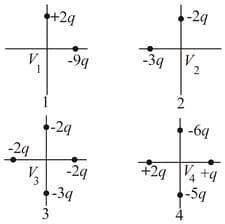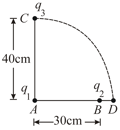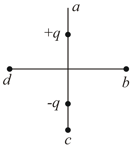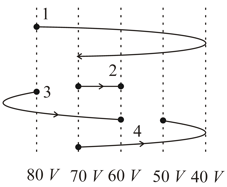Figure given shows four arrangement of charged particles, all at the same distance from the origin. Rank the situations according to the net electric potentials (V1, V2, V3, V4) at the origin, most positive first :-



Important Questions on Electrostatics
Two charges and are placed apart, as shown in the figure. A third charge is moved along the arc of a circle of radius from to . The change in the potential energy of the system is , where is:

Four points and are set at equal distance from the centre of a dipole as shown in the figure. The electrostatic potentials and would satisfy the following relation:

Figure shows a family of parallel equipotential surfaces and four paths along which an electron is made to move from one surface to another as shown.
(A) What is the direction of the electric field?
(B) Rank the paths according to work done, greatest first.


[Assume ]
